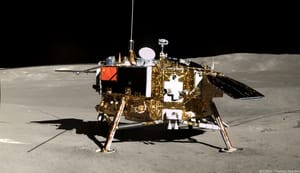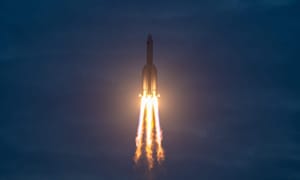
Jan 5, 2024
Celebrating five years since Chang'e 4's historic landing!
It has been over five years since the Chang'e 4 lunar lander landed on the far side of the Moon. The lunar landing occurred at 02:26 am Coordinated Universal Time on the 3rd of January 2019 touching down the Von Kármán crater in the South Pole-Aitken Basin.
This was also the first soft landing on the far side of the Moon to be achieved by any country. Chang'e 4 is also a follow-up mission to China's first lunar landing mission, Chang'e 3.
The Chang'e 4 lander and Yutu-2 rover were launched from Launch Area 2 at the Xichang Satellite Launch Center atop of a Long March 3B rocket back on the 7th of December 2018 at 18:23 pm Coordinated Universal Time.
The mission is believed to be ongoing five years later, still performing science on the surface and surpassing its twelve-month planned mission duration. Both spacecraft have survived by utilizing a radioisotope heater unit to heat their internal computers during the extremely cold lunar nights. The two spacecraft also shut off non-critical systems while the sun is directly overhead to prevent overheating.
Chang'e 4 also carried the Yutu-2 rover to the lunar surface and was deployed from the lander after touching down. The Yutu-2 rover is believed to have traveled over a kilometer on the lunar surface so far.

Seven months before the launch of Chang'e 4, the Queqiao relay satellite was launched atop of a Long March 4C rocket from Launch Complex 3 at the Xichang Satellite Launch Center in support of the lunar landing mission. The Queqiao relay satellite operates in an Earth-Moon Lagrange point 2 orbit to enable regular communications to spacecraft, like Chang'e 4, on the far side of the Moon.

In November of 2019, the Chang'e 4 team was awarded a Gold Medal by the Royal Aeronautical Society for their achievement in landing a spacecraft on the far side of the Moon. In October of 2020, the mission was awarded the World Space Award by the International Astronautical Federation.
What science experiments flew on Chang'e 4?
The Chang'e 4 lander had three experiments onboard, the Low Frequency Spectrometer, the Lunar biosphere experiment, and the Lunar Lander Neutrons and Dosimetry experiment. The Low Frequency Spectrometer, partially developed by Kiel University in Germany, studies low-frequency radio emissions using the Moon as a shield to block the Earth and focus on signals from the Sun and Moon. The Lunar biosphere experiment studies how well different types of seeds grow in lunar gravity and was run in partnership with twenty-eight Chinese Universities. The Lunar Lander Neutrons and Dosimetry experiment measures radiation on the Moon to allow teams back on Earth to plan for a crewed lunar mission in the future.
The Yutu-2 rover also had three experiments onboard, the Lunar Penetrating Radar, the Advanced Small Analyzer for Neutrals, and the Visible and Near-Infrared Imaging Spectrometer. The Lunar Penetrating Radar is a radar used to see over one-hundred meters below the surface and to measure the thickness of the lunar regolith. The Advanced Small Analyzer for Neutrals is an experiment from the Swedish Institute of Space Psychics used to discover how solar wind interacts with lunar regolith. The Visible and Near-Infrared Imaging Spectrometer is used to study the mineral composition of the surface of the Moon around the rover.
The Queqiao relay satellite also hosts an experiment developed between the Chinese Academy of Sciences and the Radboud University, located in the Netherlands, called the Netherlands–China Low-Frequency Explorer. The Netherlands–China Low-Frequency Explorer is used to perform astrophysical studies in the radio range of eighty kilohertz to eighty megahertz.



